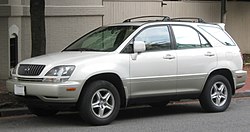Lexus RX (XU10)
 |
|
| Manufacturer | Lexus (Toyota) |
|---|---|
| Also called | Toyota Harrier |
| Production | 1997–2003 (Toyota Harrier) 1998–2003 (Lexus RX) |
| Model years | 1999–2003 |
| Assembly | Japan: Miyawaka, Fukuoka |
| Class | Compact crossover SUV |
| Body style | 4-door SUV |
| Layout | Front-engine, FWD, AWD |
| Engine | 2.2 L 5S-FE I4 2.4 L 2AZ-FE I4 3.0 L 1MZ-FE V6 |
| Transmission | 4-speed automatic |
| Wheelbase | 103.1 in (2,620 mm) |
| Length | 180.1 in (4,570 mm) |
| Width | 71.5 in (1,820 mm) |
| Height | 65.7 in (1,670 mm) |
The first generation Lexus RX was built in Kyushu, Japan. The RX 300 retained the same powertrain for its entire production run, while the inline-four powered Harrier received a larger-displacement engine in November 2000 (ACU10/ACU15). Export sales of the first generation model continued until 2003, after which the second generation RX 300/330 was introduced as its successor.
History of development
Concept (SLV)
A concept sport utility vehicle, the SLV, previewed the first generation Lexus RX at the Chicago Auto Show on February 9, 1997,a year before its introduction. The SLV name stood for Sport Luxury Vehicle. The production-ready concept combined the characteristics of an SUV, wagon, and sedan,and featured high-ground clearance and an elevated seating position. The concept's overall design intent was to be commonly used for suburban driving. At the debut of the concept vehicle, it was reported that the crossover was to be based on the ES 300 sedan, and would go into production with an entry-level price of over US$30,000.Exterior and interior
The RX 300 was built on a unibody chassis. Its exterior design was not typical of existing four-door vehicles at its introduction.Among design features, the vehicle featured front triangular quarter-windows, door-mounted side mirrors, a rear liftgate with top-mounted spoiler, and translucent front and rear light covers with round lenses. The exterior color scheme was two-tone, with the bumper and lower body-side cladding a gray color.Overall dimensions were close to the Jeep Grand Cherokee as well as minivans, but with closer ground clearance than the Jeep at 20 centimetres (7.9 in).The RX 300 carried a drag coefficient of 0.36 Cd.The RX 300 interior featured leather trim, two rows of seating, and a rear cargo area which could be concealed beneath a tonneau cover.The center dashboard was dominated by a central liquid crystal display (LCD) multi-information screen for audio, climate, and performance data,along with a U-shaped wood trim piece and a pair of air conditioning vents. The gear shift was mounted at the base of the center console, thus leaving open space below for additional storage space, legroom, or movement to the passenger-side seat. The rear seats could be adjusted forward and back, as well as fold flat for increased cargo room.Total cargo volume with the seats folded was 130 cu ft (3.68 m3).
Safety systems
Safety features included driver and passenger front airbags, front seat-mounted side torso airbags, anti-lock brakes, side impact door beams, daytime running lights, and five headrests as standard. Vehicle Stability Control, an electronic stability program, was optional at the RX 300's debut, and became standard in 2000. The Insurance Institute for Highway Safety (IIHS) rated the RX 300 "Good" overall in their frontal offset crash test.Models
SXU10 / SXU15 (1997)
Introduced in Japan in December 1997 along with V6 powered versions, the four-cylinder powered Toyota Harrier was available in front-wheel drive (SXU10) and all-wheel drive (SXU15) form. The 2.2 L 5S-FE I4 produced 102 kilowatts (137 hp) JIS and 191 N·m (141 lb·ft) of torque.Both models were fitted with a 4-speed automatic transmission. The Japanese-market Toyota Harrier could be optioned with JBL sound system, sport seats, and a leather steering wheel.The Harrier found success in the Japanese market, and was also shipped as grey imports to right hand drive markets in Asia.MCU10 / MCU15 (1997)
The V6-powered model was available in front-wheel drive (MCU10) and all-wheel drive (MCU15) form, which comprised all RX 300 sales in export markets from March 1998 to 2003, and Harrier V6 sales in Japan from 1997 to 2003. The 3.0 L 1MZ-FE V6 was rated at 164 kilowatts (220 hp) and 301 N·m (222 lb·ft). The transmission, a 4-speed automatic unit, offered a "Snow" mode which started the vehicle in second gear for better traction in adverse weather conditions.[1]For the RX 300, a 240-watt, 7-speaker Pioneer sound system was standard, while a premium Nakamichi customized sound system was available as an option. Interior features further included Walnut wood trim and an optional in-dash six-CD changer. The overall RX 300 concept, which directed SUV qualities to an on-road vehicle, was based on market research which found that merely 7 percent of SUV owners drove off-road.
In 2000, the RX 300 was refreshed with revised headlights and taillights, along with the option of high-intensity discharge (HID) headlamps. The interior also gained the option of a DVD-based navigation system. A burgundy exterior color, Venetian Red Pearl, was also offered on 1999–2000 year models.The RX 300 sold over 370,000 units in its five years on the market.The RX 300's success attracted rival makes to produce competing models, with subsequent debuts including the Acura MDX and BMW X5.







![Validate my RSS feed [Valid RSS]](valid-rss-rogers.png)















































































ไม่มีความคิดเห็น:
แสดงความคิดเห็น